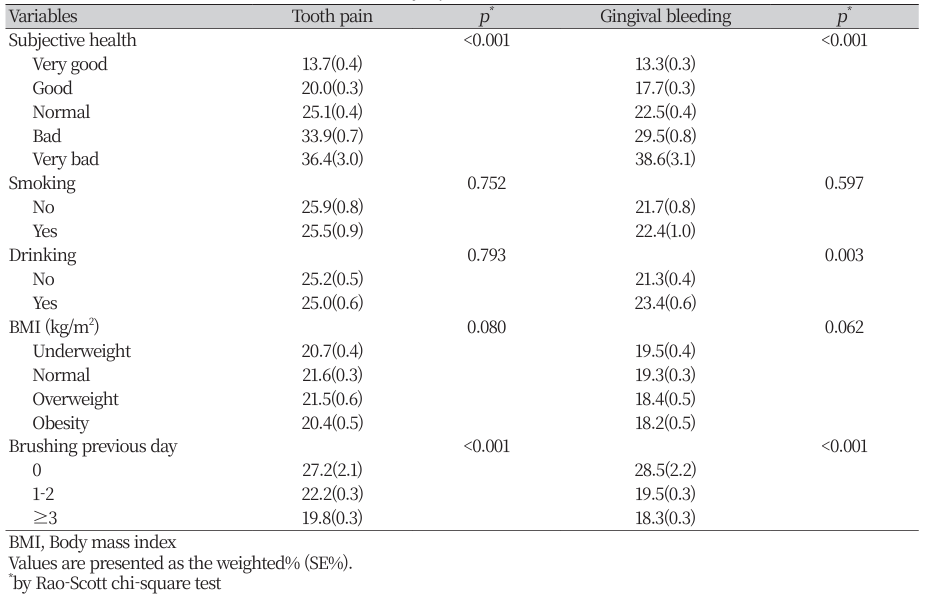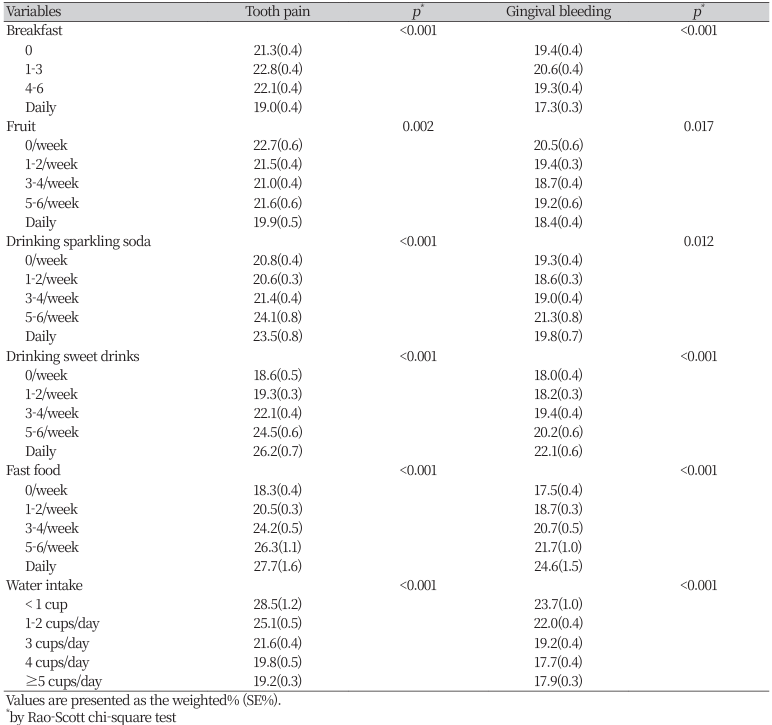Introduction
Adolescence is a period of change and development from childhood to adulthood. The lifestyle habitual of adolescents are closely related to a healthy lifestyle in adulthood [1]. The dietary habits of adolescents affect their oral health, which is closely linked to systemic health [2]. Dietary intake and oral health are closely linked to several factors. Malnutrition can affect the growth and development of the orofacial components, oral mucosa, dental disease and oral cancers. Similarly, a compromised oral cavity can affect daily food intake resulting in poor nutritional status [3].
Water constitutes the majority of the human body and is essential for health. As the body can not store water, any water lost over a period of time must be replasced [4]. In addition, drinking water can help prevent dental caries by improving salivary lubrication and self-cleaning. Increasing your daily water intake can also help reduce your intake of other drinks [5].
In addition, a lack of water in the body can lead to dry mouth and thirst, and can cause various health-related symptoms in the mouth, such as burning mouth due to oral thirst and reduced salivation. If these symptoms persist, they can create an environment conducive to oral diseases [6]. Saliva is necessary to maintain the normal function of the oral soft tissues of the mouth and to suppress oral diseases. When the salivary secretion is reduced, the buffering capacity and pH of the saliva are reduced, which can cause and increase dental caries [7].
Therefore, it is necessary to re-evaluate the relationship between dental caries and periodontal disease according to the amount of water consumed per day. Most previous studies have examined the relationship between water intake and systemic diseases [810]. However, few studies have examined the relationship between oral health behaviors and oral health status in adolescents. Therefore, in this study, we compared oral health status according to demographic characteristics, oral health disease symptoms, and water intake through an online behavioral survey of adolescents representing Korean youth and attempted to predict actual oral health status.
Methods
This study was reported in accordance with the Strengthening the Reporting of Observational Studies in Epidemiology guidelines [11].
1. Data Source and Study Participants
This study used data from the 17th Korea Youth Risk Behavior Web-Based Survey (KYRBS), 2021 conducted by the Ministry of Education, the Ministry of Health and Welfare, and the Korea Disease Control and Prevention Agency (KDCA). The KYRBS is an annual cross-sectional survey designed to collect health information from Korean adolescents. To select a nationally representative sample, the KYRBS used stratified cluster sampling to 800 sample schools (400 middle school sand 400 high schools). Health information was collected using an anonymous, self-administered online method. In the 2021 survey, 59,006 adolescents were selected, and 54,848 participated in the survey (response rate: 92.9%). The KYRBS protocol was approved by the Institutional Review Board of the KDCA (2021-06EXP-02-P-A), and informed consent was obtained from all participants prior to their participation in the study. Additional information can be found in previous studies [12,13].
2. Frequency of water intake
The participants were asked, ‘In the past seven days, how often did you drink water (including bottled water, carbonated water, barley tea, etc.)?’ The answers were categorised as ‘less than two cups a day’, ‘three to four cups a day’, and ‘more than five cups a day’.
3. Oral disease symptoms
Oral disease symptoms included toothache and gingival bleeding. Regarding toothache the participants were asked, ‘In the past 12 months, have you had a sore, throbbing, or painful tooth?’. The participants were considered to have tooth pain if they answered yes. Regarding gingival bleeding, the participants were asked, ‘Have you had any symptoms of sore or bleeding gums in the past 12 months?’. The participants were considered to have gingival bleeding if they answered yes.
4. Health status characteristics
The health status characteristics of the subjects were subjective perception of their health (very good, good, normal, poor, very poor), current smoking (no, yes), current drinking (no, yes), body mass index (BMI; underweight≤18.5 kg/㎡), normal (18.5-22.9 kg/㎡), overweight (23.0-24.9 kg/㎡), obese (≥25.0 kg/㎡), and the number of times they brushed their teeth the previous day (0, 1-2, ≥3).
5. Dietary habits
The dietary habits of the participants were determined on the basis of whether they had eaten food in the last seven days. Specifically, the participants were asked about eating breakfast (zero days, one to three days, four to six days, daily), eating fruit (zero days, one to two times, three to four times, five to six times, daily), drinking carbonated soda drinks (zero days, one to two times, three to four times, five to six times, daily), drinking sweet drinks (zero times, one to two times, three to four times, five to six times, daily), and eating fast food (zero times, one to two times, three to four times, five to six times, daily).
6. General characteristics
The general characteristics of the participants included sex (boy and girl), grade (middle school 1, 2, 3, high school 1, 2, 3), academic grades (very low, low, normal, high, very high), household economic status (very low, low, normal, high, very high), father’s education (middle school, high school, ≥college), and mother’s education (middle school, high school, ≥college).
7. Statistical analyses
All the statistical analyses were performed using complex sampling methods and procedures. General characteristics, frequency water intake, oral disease symptoms, health status characteristics, and dietary habits were analyzed. The Rao-Scott chi-square test was used to investigate differences in the overall characteristics, health-related characteristics, dietary, toothache, and gingival bleeding. Simple analysis adjusted for significant variable, and multiple logistic regression analysis was conducted to determine the relationship between frequency of daily water intake and toothache gingival bleeding. All analyses were conducted using IBM SPSS Statistics for Mac (ver. 27.0; IBM Corp., Armonk, NY USA). The threshold for statistical significance was P<0.05 for all tests.
Results
1. Oral disease symptoms according to general characteristics
Among the general characteristics of the participants, there were statistically significant differences in tooth pain and gingival bleeding according to sex, grade, academic performance, household economic status, father’s education, and mother’s education (P<0.05) (Table 1).
2. Oral disease symptoms according to health status characteristics
Looking at the health-related characteristics related to gingival pain, participants who considered themselves to be in poor health and those who brushed zero times a day had the highest rates of tooth pain at 36.4% and 27.2%, respectively. These results were considered statistically significant (P<0.05). The health-related characteristics associated with gingival bleeding were subjective health, current alcohol consumption, and brushing the previous day (P<0.05) (Table 2).
3. Oral disease symptoms according to eating habits
The variable dietary habits was related to toothache and breakfast consumption. The consumption of fruit, carbonated drinks, sweet drinks, fast food, and water intake were all statistically significant (P<0.05). It was confirmed that the higher the water intake, the lower the rate of toothache.
Dietary variables associated with gingival bleeding included the consumption of breakfast, fruit, and carbonated drinks. The consumption of sweet drinks, fast food, and water intake were all statistically significant (P<0.05). The higher the water intake, the lower the rate of gingival bleeding (Table 3).
4. Association between frequency of daily water intake and oral disease symptoms in Korean adolescents
Compared with adolescents who consumed an average of five cups of water per day, adolescents who consumed one to two glasses or less were OR (Odds Ratio); 1.14 (95% CI; Confidence Interval: 1.01-1.30) more likely to experience toothache, which was a statistically significant difference.
In addition, the odds of experiencing gingival bleeding were OR; 1.10 (95% CI: 0.96-1.25) higher in adolescents who consumed less than one to two cups of water per day compared with adolescents who consumed an average of five cups of water per day, but this result was not significant (Table 4).
Discussion
A lack of moisture in the body can create an environment that is conductive to oral diseases, such as dry mouth, tooth decay, and systemic problems. Therefore, it is necessary to re-evaluate the relationship between tooth decay and periodontal disease according to daily water intake. Adolescence is a period of change and development from childhood to adulthood. Dietary and lifestyle habits in adolescence are closely related to healthy lifestyle habits in adulthood, So, this study aimed to investigate the relationship between daily water intake and oral disease symptoms in adolescents. In this study, the incidences of toothache, gingival pain, and bleeding was high in the group with low daily water intake group. In addition, multivariate logistic regression analysis showed that, compared with those who consumed five cups of water daily, those who consumed less than one cup had 1.14 times more tooth pain, withch was a statistically significant difference. This result is similar to previous studies in which Streptococcus mutans (S. mutans) bacteria was found in a group with minimal water intake [14]. Dental diseases can be classified as dental caries or periodontal disease, both of which are caused by microbial infections. S. mutans is the major causative agent of dual caries [7]. Improving salivary lubrication and self-cleaning with drinking water [5] can reduce the incidence of dental caries caused by S. mutans. Accordingly, it is necessary to reduce the incidence of dental caries through proper education on water intake and the preparation oral health management plans. Water is also an important component of renal metabolism as it transports nutrients and excretes waste products, and although water has no calories, it provides a feeling of satiety [15]. Therefore, drinking large amounts of water is thought to prevent dental caries by reducing the intake of sugar-sweetened beverages and those that cause dental caries.
Even low water intake or mild dehydration may be associated with the risk of chronic disease [16]. Awareness of the importance of adequate water intake for health has increased [17]. While there have been many studies on the effect of adequate water intake on chronic diseases, however there is a lack of studies on oral diseases. Dental caries and periodontal disease are multifactorial diseases in which various factors work in combination. Therefore, water intake alone does not increase or decrease the likelihood of oral disease. However, the current study confirmed that water intake is related to the symptoms of oral disease. Therefore, given importance of water intake, dietary guidelines should include a recommended amount of water intake so as to prevent oral disease [18].
There are several limitations to the current study. First, there are few previous studies on water intake and oral health behaviors and conditions, making it difficult to compare and interpret the results of this study. In addition, only associations and not causal relationships can be inferred from the results, owing to the cross-sectional design. Therefore, inferred research is needed. Nevertheless, this study is important because our findings may help to motivate Korean adolescents to increase their water intake. In addition, the current study provides baseline data for establishing hydration recommendations at the national level.
Conclusions
1. Dental caries is a common childhood disease, affecting 60-90% of children and adolescents worldwide. It causes pain, infection and interferes with daily activities.
2. Research in Korean adolescents found a link between daily water intake and oral health. Those who consumed more water (5 or more cups) had less toothache.
3. Adequate water intake is essential for oral health and may help prevent oral disease.
It is recommended that dietary guidelines include recommendations for water intake to promote oral health.







